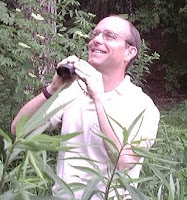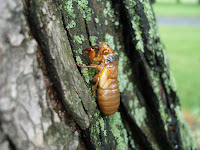NEW COLUMN: The Nature of DuPage, by Carl Strang

(POSTED: 3/1/10) Remember the periodical cicadas? In 2007 they were big news, as they are every 17 years when they emerge in the millions in the Chicago area. After a spectacular and noisy few weeks the adults died, and we forgot about them. They never left us, however. They're still around, even now, the tiny nymphs that hatched from eggs the adults left in the twigs of trees and shrubs. Late in the summer of 2007 the eggs hatched, the nymphs dropped to the ground and tunneled or followed soil cracks to reach small plant roots. There they fed on sap until they grew a little and shed their skins (exoskeletons), entering their second nymphal stage, or instar. At that point they entered a biologically significant period where they remain to this day, a quiescent four-year time of little or no growth.
This current stage in their lives is what sets our 17-year cicadas apart from the southern species, which show a similar emergence every 13 years. Each of the three northern 17-year species has a corresponding, more southern, 13-year relative. Lacking dormancy in their second instar, the 13-year cicadas grow throughout their nymphal lives and so emerge that much sooner. This time of year is an appropriate season to bring out this topic, because the leading explanation for this difference is the length, severity, and relative unpredictability of cool northern weather. Waiting longer between emergences reduces the chance that the cicadas will come out in an unfavorable year. This may have been more of a danger in glacial times, when the long lifespans and differences in emergence interval are thought to have evolved.

Researchers have found that the cicadas are not absolutely rigid in their developmental timing. I am not talking here about the few aberrant individuals who come out a year early or a year late, but rather about a phenomenon for which the Chicago area was the first documented case. In 1969, four years before the expected 1973 emergence in northeast Illinois, a percentage of periodical cicadas emerged in many of our communities. If you do the math, you will realize that for some reason this “shadow brood” must have skipped the dormancy stage, and behaved like their southern, 13-year cousins. This off-year emergence was well documented by Monte Lloyd, a Field Museum scientist who was one of his day’s leading periodical cicada researchers. He expected those atypical insects to be picked off by predators, and that would be that. However, they came out again in 1986, and again in 2003, apparently having resumed their usual 17-year lifespan.

I conducted a geographical and historical survey of periodical cicadas in DuPage County in 2007. As I mapped their emergence (incidentally discovering an interesting association between cicada distribution, commuter railways and agricultural history), I found a curious hole around the communities of Wood Dale and Addison. Those adjacent cities had practically no cicadas in 2007, but subsequent interviews and research revealed that they had experienced a significant emergence in 2003. It appears that their entire cicada population has made a shift to the shadow brood timing. So in those towns, it seems likely that the underground nymphs now are past their dormant period and in their major growth phase, pointing toward a 2020 emergence. I plan to be there to map them.
So, as you walk through a forested area or neighborhood where periodical cicadas are established, you may want to spare a thought for those millions of nymphs. They are all around you, quietly biding their time down in the soil, aiming toward their big year of 2020 or 2024, as the case may be.
By Carl Strang, who has been an interpretive naturalist for the Forest Preserve District of DuPage County for more than 28 years. He holds a Ph.D. in wildlife ecology from Purdue University. Carl has won awards from the Illinois Wildlife Federation and from the National Association for Interpretation. He is the author of the book, Interpretive Undercurrents, on the art of natural history interpretation. His weekly radio spot, "Wild Things," is broadcast from the College of DuPage radio station (WDCB, 90.9FM) on Monday evenings between 6:00 and 6:30. Current research interests include distribution and ecology of singing insects, and winter movement patterns and social structure of Canada geese.
0 comments: